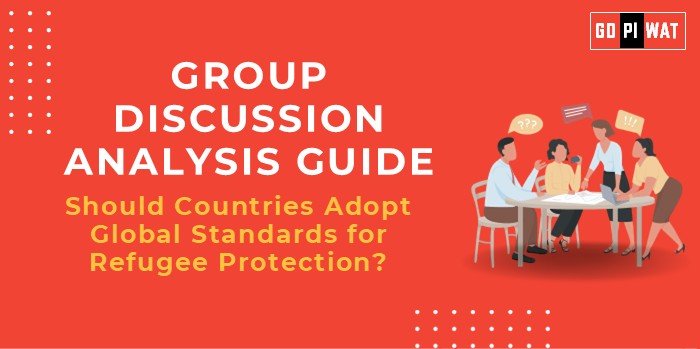📋 Group Discussion Analysis Guide
🌍 Should Countries Adopt Global Standards for Refugee Protection?
💡 Introduction to the Topic
🌱 Opening Context: “With over 108 million people displaced worldwide as of 2023, the refugee crisis represents one of the most pressing global challenges of our time.”
📜 Background: The 1951 Refugee Convention and its 1967 Protocol established a foundation for refugee protection but lack universal adoption and enforcement, leading to disparate national policies. Recent geopolitical events have exacerbated displacement, demanding cohesive global action.
📊 Quick Facts and Key Statistics
- 🌍 108 Million Displaced Globally: Refugees constitute over 35 million (UNHCR, 2023), reflecting growing instability.
- 📌 Top Refugee-Hosting Countries: Turkey (3.6 million), Colombia (2.5 million), and Pakistan (1.4 million).
- 💰 Global Funding Gap: UNHCR faces a 45% shortfall in its $10.6 billion 2024 budget.
- ⚖️ Regional Disparities: Africa hosts 26% of refugees, often with limited resources.
🌍 Stakeholders and Their Roles
- 🏛️ National Governments: Enact refugee policies, allocate resources, and ensure legal protections.
- 🌐 International Bodies: UNHCR provides humanitarian aid and advocates for legal frameworks.
- 🤝 NGOs and Advocacy Groups: Deliver on-ground assistance and raise global awareness.
- 👥 Refugees and Host Communities: Key agents experiencing and navigating the systems in place.
🏆 Achievements and Challenges
🌟 Achievements:
- ✔️ Legal Frameworks: The 1951 Refugee Convention safeguards rights in 149 countries.
- 📈 Innovative Support Models: Countries like Uganda integrate refugees into local economies.
- 🌍 Global Solidarity Efforts: Programs like the Global Compact on Refugees promote resource-sharing.
⚠️ Challenges:
- ⚖️ Inconsistent Policies: Non-ratifying nations (e.g., some Gulf States) undermine universal standards.
- 💰 Funding Deficits: UNHCR’s budget gap hampers adequate responses.
- 🌍 Geopolitical Barriers: Rising nationalism affects policy adoption and integration efforts.
🌍 Global Comparisons:
- ✅ Success: Germany’s comprehensive integration model post-2015 refugee crisis.
- ❌ Challenges: Limited refugee support in Southeast Asia due to non-ratification of key conventions.
✨ Structured Arguments for Discussion
- 💬 Supporting Stance: “Global standards ensure equitable burden-sharing and align national policies for consistent refugee rights.”
- ⚖️ Opposing Stance: “Countries have unique capacities and political contexts, making standardized policies impractical.”
- 🔄 Balanced Perspective: “Adopting global standards with localized adaptation offers a middle ground.”
🎯 Effective Discussion Approaches
📖 Opening Approaches:
- 📊 Reference the 1951 Convention’s historical importance.
- 📉 Highlight current statistics, such as 108 million displaced individuals.
- 📜 Discuss specific cases like Uganda’s refugee model.
🔄 Counter-Argument Handling:
- ✔️ “While resource constraints are real, international aid partnerships can alleviate the burden.”
- 💡 “Cultural integration challenges exist but can be mitigated through community-driven solutions.”
📈 Strategic Analysis of Strengths and Weaknesses
- 💪 Strengths: Precedents in successful integration models (e.g., Uganda), established frameworks like the Refugee Convention.
- ⚠️ Weaknesses: Enforcement and funding gaps, political resistance in key regions.
- 💡 Opportunities: Leveraging global coalitions for equitable resource sharing, using technology for efficient refugee management.
- 🚨 Threats: Rising xenophobia and geopolitical conflicts.
📚 Connecting with B-School Applications
- 🌟 Real-World Applications: Policy-making, international trade, and operational logistics for humanitarian aid.
- 💬 Sample Questions:
- “How do global refugee standards impact international relations?”
- “What role do businesses play in refugee integration?”
- 📖 Insights for Students:
- Consider leadership roles in CSR initiatives or policy design in multinational organizations.


